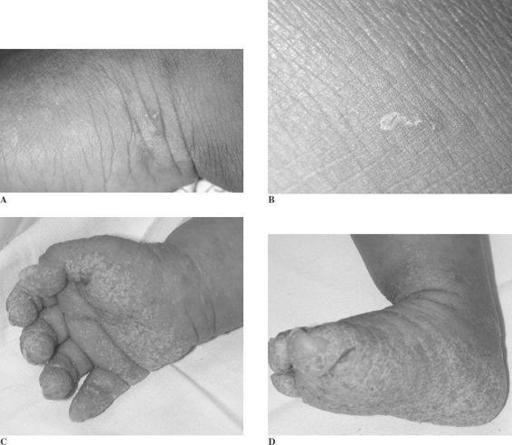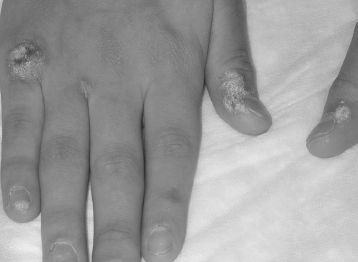Read Pediatric Examination and Board Review Online
Authors: Robert Daum,Jason Canel
Pediatric Examination and Board Review (34 page)

Lucky AW. Transient benign cutaneous lesions in the newborn. In: Eichenfield LF, Frieden IJ, Esterly NB, eds.
Textbook of Neonatal Dermatology.
Philadelphia, PA: WB Saunders; 2001:88-102.
Patel GK, Finlay AY. Staphylococcal scalded skin syndrome: diagnosis and management.
Am J Clin Dermatol.
2003;4(3):165-175.
CASE 18: AN 8-YEAR-OLD BOY WITH AN ITCHY RASH
An 8-year-old boy presents complaining of an itchy rash involving his whole body. His mother states that her son has been itchy and rashy “from birth.” She has treated his skin with “cortisone creams” and “ringworm creams” over the years, with only intermittent mild improvement. She admits that his itching and scratching have been worse in the last couple of weeks. She has not noticed a rash on her own skin, but her 6-month-old daughter also has an itchy rash (
Figure 18-1
).
On physical examination, there are excoriations over the upper back, abdomen, wrists, and lower legs. The antecubital fossae and popliteal fossae are clear. There are tiny papules on the fingers and larger erythematous papules on the scrotum. The face is clear.
SELECT THE ONE BEST ANSWER
1.
Examination of the patient’s 6-month-old sister is likely to reveal
(A) red scaly patches on the cheeks
(B) linear lesions within creases on the palms and soles
(C) annular scaling plaques on the buttocks
(D) grouped vesicles on an erythematous base in the diaper area
(E) broken and missing hairs in the scalp

FIGURE 18-1.
See color plates for parts A and B.
2.
The patient is treated with two applications of permethrin cream and returns 1 month later without improvement. The most likely cause of treatment failure is
(A) inadequate treatment of contacts and environment
(B) inadequate duration of treatment
(C) inappropriate choice of medication
(D) organism resistance
(E) misdiagnosis
3.
The patient’s mother states that she has been also applying the cream to her baby’s rash twice a day. You inform her that the treatment
(A) is appropriate and she needs to apply the medicine 3 times a day
(B) should have been applied only once to the whole body
(C) should have been applied once a week for 2 weeks to the whole body
(D) is inappropriate and you prescribe triamcinolone ointment instead
(E) is inappropriate and you prescribe mupirocin ointment instead
4.
Additional instructions for treatment should include
(A) professional extermination of the home environment
(B) shaving the head
(C) sealing all coats in plastic for 1 month
(D) applying mayonnaise to the hair and then washing it out
(E) laundering all linens and clothing and vacuuming all surfaces
5.
The finding of papules/nodules on the penis and scrotum in the setting of an itchy rash such as this child presented with is
(A) irrelevant to making the diagnosis
(B) strongly suggestive of the diagnosis
(C) pathognomonic for the diagnosis
(D) a warning sign of sexual abuse
(E) a marker of a secondary bacterial infection
6.
Later that day, a 6-year-old white girl presents complaining of an itchy scalp for a few weeks. Examination of the scalp and hair is most likely to reveal
(A) diffuse scaling of the scalp with scattered pustules and areas of broken hairs
(B) areas of decreased hair density with hairs of variable length
(C) multiple round patches of smooth alopecia
(D) greasy scale throughout the scalp
(E) white flecks in the hair that do not seem to come off easily
7.
A common cause of treatment failure in this condition is
(A) resistant organisms
(B) failure to remove all nits
(C) incorrect use of medications
(D) A and C
(E) all of the above
8.
Many schools advocate a “no nit” policy when evaluating whether students may return to school. The problem with this policy is
(A) nits represent egg sacs and never indicate active infestation
(B) it requires all children to cut their hair short
(C) nits that are less than 3 inches from the scalp are empty
(D) nits that do not contain a live organism are noninfectious
(E) nits can only be seen microscopically
9.
The best place to detect body lice is
(A) under the nails
(B) by a perianal tape test
(C) in the umbilicus
(D) in the digital web spaces
(E) in the seams of clothing
10.
A 2-year-old girl presents with new bumps on the skin for the last few weeks. They do not seem to itch or otherwise bother the child. On examination you notice numerous flesh-colored 2- to 3-mm smooth papules, some with a central dell, clustered behind the knee and scattered on the thigh, groin, and trunk (
Figure 18-2
). You inform the patient’s mother that
(A) the patient has chickenpox and must be kept out of school
(B) this is an allergic contact reaction and you prescribe topical hydrocortisone
(C) the house requires fumigation by an exterminator service
(D) this is a poxvirus infection and there is no associated systemic involvement
(E) this is a papilloma virus infection for which the patient should be immunized
11.
Appropriate treatment for this eruption includes
(A) watchful waiting
(B) calamine lotion
(C) triamcinolone ointment
(D) salicylic acid solution
(E) vaccination

FIGURE 18-2.
See color plates.
12.
At this same visit, the patient’s 12-year-old brother shows you some firm rough papules on his fingers, which he states have bled when he picks at them (
Figure 18-3
). On examination, these papules have a rough surface studded by pinpoint black dots. The most likely diagnosis is
(A) callous
(B) verruca
(C) knuckle pads
(D) foreign body reaction
(E) molluscum contagiosum

FIGURE 18-3.
See color plates.
13.
The treatment of choice for this condition is
(A) cryotherapy
(B) surgical excision
(C) electrocautery
(D) curettage
(E) vaccination
14.
Soft flesh-colored coalescent papules in the perianal area on this patient suggest
(A) the need for a child abuse evaluation
(B) the patient is constipated and needs to increase fiber in his diet
(C) autoinoculation of human papillomavirus
(D) A and C
(E) all of the above
15.
A 9-year-old boy presents to the emergency department with a 2-day history of blisters erupting on his lower legs (
Figure 18-4
). He complains that his legs are itchy and somewhat sore, but he otherwise feels well and is afebrile with normal vital signs. You instruct the family

